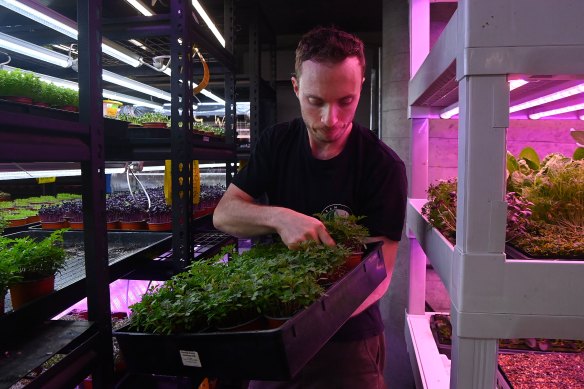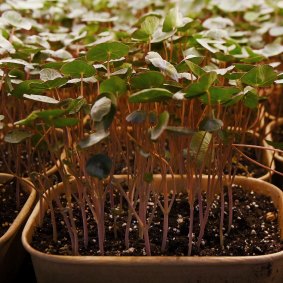By Julie Power
It was the week-old “nose ticklers” grown in an underground car park in Sydney’s Barangaroo that first sparked top chefs’ interest in the 40 species of microgreens being farmed at Noah Verin’s Urban Green.
The pioneer of one of the world’s first underground farms, Verin said the nasturtium seedlings (from the Latin word for nose tickler) were like “looking into a galaxy” far, far away.

Noah Verin in his underground farm.Credit: Kate Geraghty
Now growing microgreens ranging from melon, mizuna, chervil, peas, basil, coriander and chives, Verin said the best microgreens had the holy trinity: flavour, an interesting aesthetic and a different texture.
“Nasturtiums [with their peppery flavour] tick all the boxes. They are hydrophobic so if you spray them the water falls off, they have an interesting texture – and they look cool,” he said.
Tours of Verin’s 120 square metre farm in a car park four floors below ground in Barangaroo and the Jiwah Indigenous garden, four levels above ground on a rooftop in South Eveleigh, are among 60 events across the city from September 15 to 24 during the Powerhouse Museum’s Design Week.

The tiny nasturtium sprouts remind urban farmer Noah Verin of a galaxy far, far away. Credit: Kate Geraghty
Design Week’s creative director Keinton Butler said the program brings together research, industries, infrastructure and technologies to explore contemporary design.
The two gardens demonstrated different ways to produce food for a growing population.
Verin, an environmental scientist and a former chef, said by 2050, almost five billion people would be living in cities, representing 70 per cent of the global population. Because of this, humans were developing increasingly creative ways to produce food, with urban farming promising to be a large part of the solution.
Microgreens, like the ones he grows, have been shown to have about four times as many nutrients per gram as more mature plants.
When he started the farm with a loan from his family, Verin didn’t intend to lead a revolution that transform underutilised space. “But it fast became clear to me that vertical farming was a revolutionary concept. Food can be grown anywhere with power and water.”
Despite some growing pains, and with help from online videos, he learnt how to grow vegetables under lights in an insulated corner of the car park.“It is so incredibly exciting to put a farm in the middle of the CBD under the people who are going to eat the produce.”
Verin is now selling about 4000 punnets of herbs and baby greens a week – mostly grown in recyclable containers instead of plastic – of microgreens to restaurants, including vegetarian eatery Yellow and the award-winning restaurant Tetsuya’s, and to the public, mostly delivered by bicycle.
Clarence Slockee, who appears on ABC’s Gardening Australia and is an Indigenous expert on biodiversity and bush tucker, runs the 500 square metre Indigenous rooftop farm called Jiwah.
“It is always a work in progress,” he said. They give away a lot of what they grow. “It is never going to be a money-making venture,” Slockee said.
Research showed the garden had increased the number of pollinators and plant species, and had improved understanding among the public of Indigenous plants.
Slockee said the smart money was on using rooftop gardens to reduce energy consumption, including the need to heat and cool the building underneath, and increase biodiversity.
“The nicest thing about this roof is that it is canopy height for surrounding trees. It is in the sweet spot. It is tough to go higher than four floors and attract pollinators,” he said.
The rooftop operates as a public space used by community groups. Maintenance costs are covered by Mirvac, the owner of the building, and the garden helped it achieve a Green Star Rating.
Public tours of the gardens are scheduled for September 16. Other tours include the Australian PlantBank on September 17.
The Morning Edition newsletter is our guide to the day’s most important and interesting stories, analysis and insights. Sign up here.